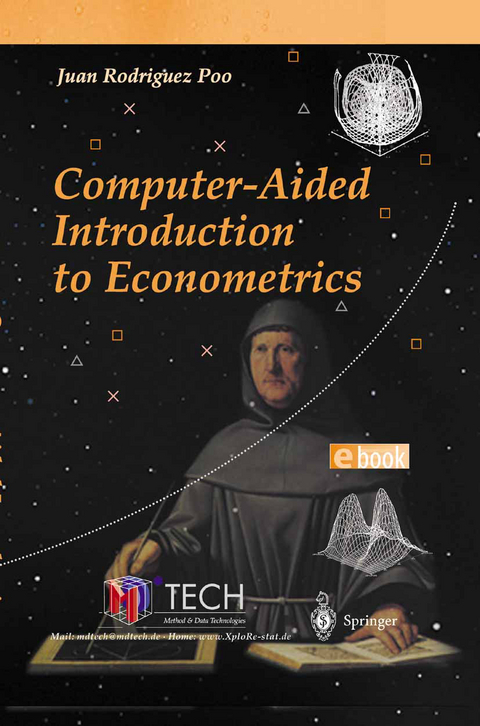
Computer-Aided Introduction to Econometrics
Springer Berlin (Verlag)
978-3-642-62901-3 (ISBN)
This book provides graduate students and researchers not only with a sound theoretical introduction to the topic, but allows the reader through an internet based interactive computing method to learn from theory to practice the different techniques discussed in the book. Among the theoretical issues presented are linear regression analysis, univariate time series modelling with some interesting extensions such as ARCH models and dimensionality reduction techniques.
The electronic version of the book including all computational possibilites can be viewed at
http://www.xplore-stat.de/ebooks/ebooks.html
1 Univariate Linear Regression Model.- 1.1 Probability and Data Generating Process.- 1.2 Estimators and Properties.- 1.3 Inference.- 1.4 Forecasting.- 2 Multivariate Linear Regression Model.- 2.1 Introduction.- 2.2 Classical Assumptions of the MLRM.- 2.3 Estimation Procedures.- 2.4 Properties of the Estimators.- 2.5 Interval Estimation.- 2.6 Goodness of Fit Measures.- 2.7 Linear Hypothesis Testing.- 2.8 Restricted and Unrestricted Regression.- 2.9 Three General Test Procedures.- 2.10 Dummy Variables.- 2.11 Forecasting.- 3 Dimension Reduction and Its Applications.- 3.1 Introduction.- 3.2 Average Outer Product of Gradients and its Estimation.- 3.3 A Unified Estimation Method.- 3.4 Number of E.D.R. Directions.- 3.5 The Algorithm.- 3.6 Simulation Results.- 3.7 Applications.- 3.8 Conclusions and Further Discussion.- 3.9 Appendix. Assumptions and Remarks.- 4 Univariate Time Series Modelling.- 4.1 Introduction.- 4.2 Linear Stationary Models for Time Series.- 4.3 Nonstationary Models for Time Series.- 4.4 Forecasting with ARIMA Models.- 4.5 ARIMA Model Building.- 4.6 Regression Models for Time Series.- 5 Multiplicative SARIMA models.- 5.1 Introduction.- 5.2 Modeling Seasonal Time Series.- 5.3 Identification of Multiplicative SARIMA Models.- 5.4 Estimation of Multiplicative SARIMA Models.- 6 Auto Regressive Conditional Heteroscedastic Models.- 6.1 Introduction.- 6.2 ARCH(1) Model.- 6.3 ARCH(q) Model.- 6.4 Testing Heteroscedasticity and ARCH(1) Disturbances.- 6.5 ARCH(1) Regression Model.- 6.6 GARCH(p,q) Model.- 6.7 Extensions of ARCH Models.- 6.8 Two Examples of Spanish Financial Markets.- 7 Numerical Optimization Methods in Econometrics.- 7.1 Introduction.- 7.2 Solving a Nonlinear Equation.- 7.3 Solving a System of Nonlinear Equations.- 7.4 Minimization of a Function: One-dimensional Case.- 7.5 Minimization of a Function: Multidimensional Case.- 7.6 Auxiliary Routines for Numerical Optimization.
From the reviews:
"The usefulness of the book lies in the fact that the reader, along with learning the theory, can actually practice the different techniques described in the book through an internet based interactive computing method. The electronic version of the book including all computational possibilities can be viewed and downloaded at http:// www.xplore-stat.de. The book should be very useful to students and researchers working in the area of econometrics. Professor Rodriguez Poo has done a good job in compiling the chapters." (Amita Majumder, Sankhya: The Indian Journal of Statistics, Vol. 66 (2), 2004)
"This book is a collection of seven contributions to different fields of econometrics ... . The book is addressed to undergraduate students and/or applied researchers and practitioners to develop professional skills in econometrics. The basic intention of the book is to teach econometrics using the resources from the internet by incorporating an interactive computing internet based method that allows to practice all the techniques presented and discussed in this book. Therefore the editor refers to his book as an e-book." (Herbert S. Buscher, Zentralblatt MATH, Vol. 1012, 2003)
"The special feature of the book is its strong interrelation with the econometric internet software package XploRe ... . The set of methods that are covered in the book give an interesting introduction to the elementary and some advanced topics in econometrics and time series analysis. ... Bibliographies are given at the end of each chapter ... . The book is an interesting treatment of the subject and may well serve as a textbook for a course in applied econometrics for students or practitioners." (Peter Hackl, Statistical Papers, Vol. 45 (4), 2004)
| Erscheint lt. Verlag | 4.10.2012 |
|---|---|
| Zusatzinfo | XVII, 331 p. |
| Verlagsort | Berlin |
| Sprache | englisch |
| Maße | 155 x 235 mm |
| Gewicht | 539 g |
| Themenwelt | Mathematik / Informatik ► Mathematik |
| Wirtschaft ► Allgemeines / Lexika | |
| Wirtschaft ► Volkswirtschaftslehre ► Ökonometrie | |
| Schlagworte | Computational Methods in Econometrics • Econometrics • Linear Regression Analysis • Modeling • Optimization Methods • Simulation • Univariate time Series Modelling |
| ISBN-10 | 3-642-62901-6 / 3642629016 |
| ISBN-13 | 978-3-642-62901-3 / 9783642629013 |
| Zustand | Neuware |
| Informationen gemäß Produktsicherheitsverordnung (GPSR) | |
| Haben Sie eine Frage zum Produkt? |
aus dem Bereich


